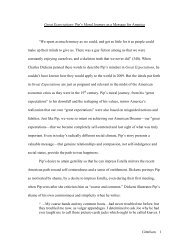Dombey and Son - 2002 (PDF) - The Dickens Project
Dombey and Son - 2002 (PDF) - The Dickens Project
Dombey and Son - 2002 (PDF) - The Dickens Project
Create successful ePaper yourself
Turn your PDF publications into a flip-book with our unique Google optimized e-Paper software.
ibliography<br />
Marcus, <strong>Dickens</strong>: From Pickwick to <strong>Dombey</strong> (New York: Basic Books, 1965) has proven almost as influential<br />
<strong>and</strong> is informed by psychoanalytic <strong>and</strong> sociological theory; after Marcusís book appeared, it was simply<br />
impossible to disregard <strong>Dickens</strong> any longer as a major nineteenth-century thinker. Marcusís "Language into<br />
Structure: Pickwick Revisited," Daedalus 101 (1972), 183-202 (reprinted in Bloom) virtually makes the case for<br />
<strong>Dickens</strong> as a major twentieth-century thinker as well in looking at recognizably modernist features even of<br />
<strong>Dickens</strong>ís earliest work. Garrett Stewartís <strong>Dickens</strong> <strong>and</strong> the Trials of Imagination (Cambridge, Massachusetts:<br />
Harvard University Press, 1974) is also valuable on Joycean <strong>and</strong> Nabokovian anticipations in <strong>Dickens</strong>ís style<br />
<strong>and</strong> is itself admirably stylish. Patrick J. McCarthy's, "<strong>The</strong> Language of Martin Chuzzlewit." Studies in English<br />
Literature, 1500-1900 20 (1980), 637-49 is another influential study of the style of <strong>Dickens</strong>.John Romanoís<br />
<strong>Dickens</strong> <strong>and</strong> Reality (New York; Columbia University Press, 1978) aims to correct Millerís attraction to the idea<br />
that reality is a fictionóas for example also in Millerís "<strong>The</strong> Fiction of Realism: Sketches by Boz, Oliver Twist,<br />
<strong>and</strong> Cruikshankís Illustrations," <strong>Dickens</strong> Centennial Essays, ed. Ada Nisbet <strong>and</strong> Blake Nevius (Berkeley:<br />
University of California Press, 1971)óby reminding us, especially through a reading of Our Muutal Friend, of<br />
<strong>Dickens</strong>ís realistic <strong>and</strong> referential allegiances.<br />
F. R. <strong>and</strong> Q. D. Leavisís <strong>Dickens</strong> the Novelist (London: Chatto <strong>and</strong> Windus, 1970) signaled a major shift in<br />
opinion by Engl<strong>and</strong>ís most important <strong>and</strong> controversial critic of the mid-twentieth century, who, in his<br />
extremely influential <strong>The</strong> Great Tradition (London: Chatto <strong>and</strong> Windus, 1948) had relegated <strong>Dickens</strong> to an<br />
appendix; here (as in his Clark lectures of 1967) Leavis put <strong>Dickens</strong> at the very center of his history not just of<br />
the novel, but of English literature more generally. Raymond Williams, writing out of a Marxist <strong>and</strong> Welsh<br />
working-class background, offered the other most intellectually challenging readings of <strong>Dickens</strong> in Great Britain<br />
at mid-century, especially in his Culture <strong>and</strong> Society: 1780-1950 (London: Chatto <strong>and</strong> Windus, 1958)óa vital<br />
book for all Victorianistsó<strong>and</strong> more expansively in his chapter on <strong>Dickens</strong> in <strong>The</strong> English Novel: from <strong>Dickens</strong> to<br />
Lawrence (London: Chatto <strong>and</strong> Windus, 1970) <strong>and</strong> in essays such as "<strong>Dickens</strong> <strong>and</strong> Social Ideas," <strong>Dickens</strong>, 1970,<br />
ed. Michael Slater (London: Chapman <strong>and</strong> Hall, 1970). D. A. Millerís essays on Oliver Twist, David Copperfield,<br />
<strong>and</strong> especially his Foulcauldian reading of Bleak House (reprinted in both Bloom <strong>and</strong> Connor) in <strong>The</strong> Novel <strong>and</strong><br />
the Police (Berkeley: University of California Press, 1988) st<strong>and</strong> out among most recent influential work. Miller<br />
has a fine sense for the ways in which the novels collaborate in Victorian cultureís "carceral" tendencies while<br />
appearing to oppose them.<br />
Important <strong>and</strong> representative criticism on somewhat more specialized special aspects includes James R.<br />
Kincaid, <strong>Dickens</strong> <strong>and</strong> the Rhetoric of Laughter (Oxford: Clarendon, 1971) <strong>and</strong> Robert M. Polhemusís chapter on<br />
Martin Chuzzlewit in Comic Faith (Chicago: University of Chicago Press, 1980). Ian Watt, "Oral <strong>Dickens</strong>,"<br />
<strong>Dickens</strong> Studies Annual 3 (1974), 165-181 is a tour de force of thematic criticism that makes one regret Watt did<br />
not publish more about <strong>Dickens</strong>. John O. Jordan, "<strong>The</strong> Medium of Great Expectations," <strong>Dickens</strong> Studies Annual<br />
11 (1983), 73-88 is very astute in underst<strong>and</strong>ing Pip as narratoróin seeing the adult Pip always mediating the<br />
experiences of the childish Pip. Peter Brooksís likewise narratological essay on GE in Reading for the Plot (New<br />
York: Alfred A. Knopf, 1984) is an established classic that shows (like the work of Welsh) how to be at once<br />
heavily indebted to Freud <strong>and</strong> originalóas well as free of jargon. Catherine Gallagher, <strong>The</strong> Industrial<br />
Reformation of English Fiction, 1832-1867 (Chicago: University of Chicago Press, 1985) contains an excellent<br />
chapter on the contradictions in domestic ideology apropos Hard Times <strong>and</strong> Gaskellís North <strong>and</strong> South. John<br />
Kucichís Repression In Victorian Fiction: Charlotte Bronte, George Eliot, <strong>and</strong> Charles <strong>Dickens</strong> (Berkeley:<br />
University of California Press, 1987) has an important chapter on Our Mutual Friend informed by the<br />
unclassifiable French precursor of postmodernism, Georges Bataille, <strong>and</strong> Eve Kosofsky Sedgwickís chapter on<br />
the same novel in Between Men (New York: Columbia University Press, 1985) gives us the first major reading of<br />
"homosocial desire" in <strong>Dickens</strong> <strong>and</strong> is interesting as well about class. David E. Musselwhite, Partings Welded<br />
Together: Politics <strong>and</strong> Desire in the Nineteenth-Century English Novel (London: Methuen, 1987) has a long yet<br />
bracing chapter on <strong>Dickens</strong> in spite of being steeped in some fairly abstruse theory (most notably Gilles Deleuze <strong>and</strong><br />
Felix Guattariís theory of desire). Ian Duncan, Modern Romance <strong>and</strong> Transformations of the Novel (Cambridge:<br />
Cambridge University Press, 1990) discusses <strong>Dickens</strong> as Scottís heir to the role of "national author." Richard Maxwell,<br />
<strong>The</strong> Mysteries of Paris <strong>and</strong> London (Charlottesville: University Press of Virginia, 1992) studies <strong>Dickens</strong>ís <strong>and</strong> Victor<br />
Hugoís revival of allegory in their epistemologies of the city. Malcolm Andrews, <strong>Dickens</strong> <strong>and</strong> the Grown-Up Child<br />
(Iowa City: University of Iowa Press, 1994) is the best study of <strong>Dickens</strong>ís very complicated thinking about childhood<br />
<strong>and</strong> sets this off against an excellent account of nineteenth-century thought about childhood more generally. Joseph<br />
http://dickens.ucsc.edu/bibliographies/dombeybiblio/DS_Biblio.html[11/22/11 10:42:15 AM]



